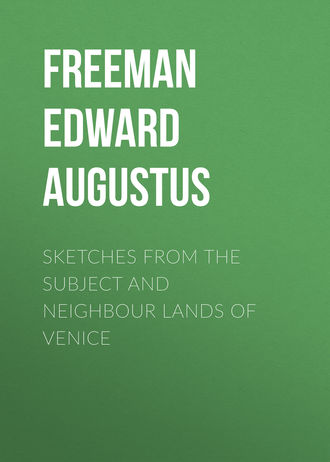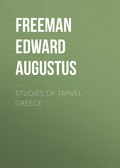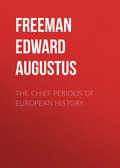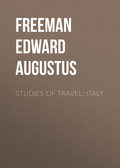
Freeman Edward Augustus
Sketches from the Subject and Neighbour Lands of Venice
SPALATO TO CATTARO
SPALATO TO CATTARO
1875
[I have not thought it needful to strike out of this paper a few allusions to the times when it was written, the early days of the revolt in Herzegovina with which the war of 1875-1878 began.]
As Spalato must be looked on as the great object of a Dalmatian voyage, it may also be looked on as its centre. After Spalato the coast scenery changes its character in a marked way. Hitherto hills, comparatively low and utterly barren, come down straight to the sea, while the higher mountains are seen only farther inland. From this point the great mountains themselves come nearer to the water. We are thus reminded of the change in the political boundary, how from this point the Hadriatic territory of Austria and of Christendom becomes narrower and narrower, till we reach the stage when the old dominion of Ragusa becomes a mere fringe between the sea and the Turk, fenced in from the former land of Saint Mark by the two points at either end where the less dangerous infidel was allowed to spread himself to the actual sea-board. But as the mountains come nearer to the sea, a fringe of cultivation, narrower or wider, now spreads itself between them and the water. Small towns and villages, detached houses, land tilled with the vine and the olive, now skirt the bases of the mountains, in marked contrast to the mere stony hills of the earlier part of the voyage. The islands too among whose narrow channels we have to make our way change their character also. After Spalato, instead of mere uninhabited rocks, we come to islands of greater size, some of them thirty or forty miles long, islands several of which have a distinct place in history, islands containing towns and cities, and which are still seats of industry and cultivation. These are the islands which give such a marked character to the map of this part of the Hadriatic, and they form the most marked feature in the fourth day's voyage of the course from Trieste to Cattaro. The endless islands which we have seen along the northern part of the Dalmatian shore, bare and uninhabited rocks as many of them are, are without history. Some of the Croatian islands indeed have somewhat of a history; but with these we are not dealing; the barren archipelago of Zara could never have had any tale to tell. First we pass through the channel which divides the mainland from the large island of Brazza, distinguished at a glance by its solid shape from its endless long and narrow fellows. Dreary and rocky as it seems, it is the most populous and industrious of the group, and at one point of its coast, San Pietro, the steamer makes a short halt. So it does at the picturesque little port of Almissa on the mainland, a nest of houses and trees at the mountain's foot, standing so invitingly as to make the traveller wish for a longer sojourn. Then comes Makarska, where we are allowed a short glimpse of the little hill-side town, smaller and more Dalmatian than any that we have yet seen. Presently we plunge into the full intricacies of the Dalmatian seas. We pass through the narrow channel which parts the mainland from the eastern promontory of the long, slender island of Lesina – the awl. Here we come within old Hellenic memories. We are now within the full range of Greek colonization, though of Greek colonization only in its latest stage. Issa, now Lissa, Black Korkyra, now Curzola, amongst the islands, and Epidauros on the mainland, were all of them undoubted Greek settlements. But Issa and Pharos, the only ones to which we can fix a positive date, were colonized only in the first half of the fourth century, and Dionysios of Syracuse had a hand in their colonization. Lesina is Pharos, the ancient colony of the Ægæan Paros, whose name still lives on Slavonic lips in the shape of Far or Hvar. It plays a considerable part in the history of Polybios, as the island of that Dêmêtrios whose crooked policy formed an important element in the affairs of mankind in the days when Greek and Roman history began to flow together into one stream. These islands form one of the highways by which Rome advanced to the possession of Illyricum, Macedonia, and Greece. But we see neither the ancient nor the modern city, neither Pharos nor Lesina; we merely skirt the island to find ourselves in the channel of Narenta. That name suggests yet another pirate power, later than that of Tenta and Dêmêtrios, that power of the old Pagania against which Venice, in her early days, had to wage so hard a struggle. We seem to be pressing on between the mainland and a long, slender, mountainous island; but our course suddenly turns; the seeming island is no other than the long peninsula of Sabioncello, a peninsula not Venetian but Ragusan. We get merely a glimpse down the gulf, at the end of which Turkish Klek once divided the possessions of the two maritime commonwealths, and still, nominally at least, breaks the continuity of Austrian dominion. But, if the peninsula was Ragusan, a narrow channel only parts it from an island which was a chief seat of the power of the rival city. We skirt the western horn of Sabioncello, and another turn leads us through the channel – narrower than any through which we have passed – which divides it from Curzola, Black Korkyra of old. We stop for a little while off the island capital, the fortress of Curzola, which was to the declining navy of Venice what Pola now is to the rising navy of Austria. This channel passed, we come to the last of the great islands. For miles and miles we skirt the Ragusan island of Meleda, long, slender, with its endless hills of no great height standing up like the teeth of a saw – a true sierra in miniature. Here volumes of scriptural controversy are open to us. As we are not tossed up and down in Hadria, but are floating along as on a lake or a river, we muse on the claims which all local and some independent authorities have set up for Illyrian Meleda, as against Phœnician Malta, to be the true seat of the shipwreck of Saint Paul. But Meleda can have its claims admitted only on the condition of being shut out from Hellenic fellowship, even though its barbarians were of a mood which led them to show no little kindness to strangers. It is hard also to understand how those who were making their way from Meleda to any point of Italy could have any possible business at Syracuse. At all events, with Meleda the island history ends, though the island scenery does not end as yet. Several islands, smaller than these more famous ones, but not so small as they look on the map, fringe the coast till we enter the haven of Gravosa, the port of modern Ragusa, with its thickly wooded shores, a marked contrast to the bleakness and barrenness of so many other points of the Dalmatian coast.
Ragusa, the city of argosies, the commonwealth which so long was the rival of Venice and which never stooped to be her subject, so thoroughly suggests maritime enterprise by her very name, that we are surprised to find that Ragusa herself has ceased to be a port of any moment. Her mighty walls, her castles, her more distant forts, still rise out of the sea, and the mightier wall of mountains just behind her still fence off her land, as the narrowest rim of Christendom, from the land of the infidel beyond. All this is as it was; modern military art has added to the defences of Ragusa, but it has not taken away her elder bulwarks. But her haven is now of the very smallest, and admits only vessels of the smallest size. The modern haven is at Gravosa, and the road which Sir Gardner Wilkinson describes as so well kept, but as useless because no carriages went upon it, is still as good and more useful. At this moment Ragusa bears the honourable character of a city of refuge for the unhappy ones who seek shelter under the government of a civilized state from the barbarian rule beyond the mountains. Her suburbs are crowded with women and children flying from the seat of war, for whom the charity both of the state and of private persons is doing much, but whose sufferings – as one who has seen them can bear witness – cry for the sympathy and help of all who have hearts and who have not invested in Turkish bonds. As we pass by and look on the city – no city surely fronts the sea more proudly than Ragusa – as we turn round to the island of La Croma, lying off what was Ragusa's harbour, the island which suggests the names of Richard of Poitou and of Maximilian of Mexico – the scene is so peaceful and lovely, the warlike defences look such mere things of the past, that it is hard indeed to believe that, just beyond the mountain barrier, warfare is going on in its bitterest and yet its noblest form – the struggle of an oppressed people to cast off the yoke of ages. This form of speech may grate somewhat on the received phrases of Western diplomacy; but, however we might be bound to write in England, in Dalmatia – so close to the facts – we may be allowed to write as all men in Dalmatia think and speak. We pass La Croma, and our time among the islands is over; no other that can be called more than a mere rock meets us between Ragusa and Cattaro. At last we enter the loveliest of inlets of the sea, the Bocche di Cattaro. A narrow strait leads us between points of land which were once Ragusan on the west and Venetian to the east, into the winding gulf, girded by mountains, and now for nearly its whole extent fringed by towns, villages, houses, cultivation in every form – a land where the sublimity of the rugged mountain has come into close partnership with the loveliness of the smiling dwelling-places of man. As we pass through the strait, a piece of barren mountain to the left marks the second piece of territory where the Turk was allowed to isolate the two commonwealths, and where, in name, his dominion still reaches to the shore of the lovely gulf. We pass on, as on the smoothest of lakes, round mountain headlands, with their rich fringe of life, by towns and villages, many of which have their own local history both in earlier and later times, till we reach the most distant of Dalmatian cities, Cattaro at the innermost point of her own unrivalled Bocche. Hemmed in between the mountains and the sea – though it seems almost strange to apply the word sea to the gentle waters of her harbour – with the mountains again rising on the other side, Cattaro seems indeed to be the end of its own world. Yet in the days of Venetian greatness, Cattaro was far indeed from being the last point of the dominion of Saint Mark. Climb the heights above the city, and the eye stretches far away along the Albanian coast, a coast along which many a city and island once bowed to the winged lion, till in fancy we track our course, as by stepping stones along the sea, to distant Crete and to more distant Cyprus.
Cattaro, the end of the outward journey, will also be the beginning of the journey back again. The little town, with its narrow paved streets, its little piazze, still keeps up the same Venetian tradition as elsewhere. And the walls of the fortress climbing far up the mountain show how firm was the grasp of the ruling city over its subjects. But at Cattaro and throughout the Bocche another feature strikes us which we do not see either at Spalato or at Ragusa. The churches do not all belong to one denomination; the Eastern, the Orthodox, Church, holds its own in this corner of Venetian or Austrian rule at least as firmly as its Latin rival. The fact is, what is forced upon our notice at every step, that, the further we go along this coast, the Italian element dies out and the Slavonic element grows. It is so in language, in dress, in everything. Zara, Spalato, Ragusa, Cattaro, each city is less and less Italian according to its geographical position. The inland country is, of course, Slave throughout. But at Cattaro the Slave element distinctly predominates, even in the town; Italian can hardly be said to be more than the best known among foreign languages. The pistol and yataghan worn in the belt, a general costume essentially the same as that of the Montenegrin, has gradually been growing upon us; here in Cattaro it is the rule, almost more than the rule. In short, the Bocchese, the Montenegrin, the Turkish rayah of Herzegovina, really differ in nothing but the difference of their political destinies. They are members of the same immediate family, whose fortunes have led them in three different directions. Now the religious tendency of the south-eastern Slaves, as is only natural from their geographical position, has always been towards the Eastern Church rather than the Western, towards the New Rome rather than towards the Old. Here, where the Slavonic element is so distinctly the stronger, the religious developement has taken its natural course, and the Orthodox population in Cattaro and all the coasts thereof is always a large minority, and in some places it actually outnumbers the Latins.
We have professed to give only the impressions of the outward voyage, though our account may have here and there been influenced by later impressions drawn from fuller observation on the way back. But the way back, and the fuller knowledge gained in its course, only brings out more strongly the intense charm of Dalmatian coast and mountain scenery, fitly united with the deep historic interest of cities which, though they seem to form a world apart by themselves, have played their part in the world's history none the less. No one can visit Dalmatia once without a wish that his first visit may not be his last; no one can take a glimpse of any of her cities without the desire that the glimpse may be only the forerunner of more perfect knowledge.
CURZOLA
1881
We part from Spalato; by the time that we have made two or three voyages in these seas, we shall find that there are several ways of reaching and parting from Spalato. We speak of course of ways by sea; by land there is but one way, and that way leads only to and from places at no great distance, and it does not lead to or from any place in the direction in which we are now bent. By sea the steamer takes two courses. One keeps along the mainland, that which allows a glimpse of the little towns of Almissa and Makarska, both nestling by the water's edge at the mountain's foot. Of these Almissa at least has an historical interest. Here Saint Mark was no direct sovereign; his lion, if we rightly remember, is nowhere to be seen, a distinction which, along this whole line of coast, Almissa alone shares with greater Ragusa. Was it a commonwealth by itself, cradled on the channel of Brazza like Gersau on the Lake of the Four Cantons? Or was it the haven of the inland commonwealth of Polizza, which, like Gersau and a crowd of other commonwealths, perished at the hands of their newborn French sister for the unpardonable crime of being old? But far more interesting is the other route of the steamers, that which leads us among the greater islands. Here, as soon as we pass Spalato, as soon as we pass the greatest monument of the dominion of Rome, we presently find ourselves in a manner within the borders of Hellas. We pass between Brazza and Solta, we skirt Lesina and think once more of its old Parian memories. We look out on Lissa, where the Hellenic name lives on with slighter change, but we are more inclined to dwell on those later memories which have made its name an unlucky one in our own day, a far luckier one in the days of our grandfathers. At last we make our first halt for study where a narrow strait divides the mainland, itself all but an island, from another ancient seat of Greek settlement, the once renowned isle of Curzola.
Curzola – such is its familiar Italian form – is the ancient Black Korkyra, and on Slavonic lips it still keeps the elder name in the shape of Kerker. But the sight of ἡ μέλαινα Κόρκυρα suggests a question of the same kind as that which the visitor is driven to ask on his first sight of Montenegro. How does a mass of white limestone come to be called the Black Mountain? Curzola can hardly be called a mass of white limestone; but the first glance shows nothing specially black about it, nothing to make us choose this epithet rather than any other to distinguish this Hadriatic Korkyra from the more famous Korkyra to the south. That some distinguishing epithet is needed is shown by the fact that, not so very long ago, a special correspondent of the Times took the whole history of Corfu and transferred it bodily to Curzola. The reason given for the name is the same in Curzola and in Montenegro. The blackness both of the island and of the mountain is the blackness of the woods with which they are covered. True the traveller from Cattaro to Tzetinje sees no woods, black or otherwise; but he is told that the name comes from thick woods on the other side of the principality. So he is told that Black Korkyra was called from its thick woods, its distinctive feature as compared with the many bare islands in its neighbourhood. But no black woods are now to be seen in that part of the island which the traveller is most likely to see anything of. There were such, he is told; but they have been cut down on this side, while on the other side they still flourish. As things are now, Curzola is certainly less bare than most of its fellows; but the impression which it gives us is, of the two, rather that of a green island than of a black one. It is not green in the sense of rich verdure, but such trees as show themselves give it a look rather green than black. At any rate, the island looks both low and well-covered, as compared with the lofty and rocky mountains of the opposite peninsula of Sabioncello. The two are at one point, and that a point close by the town of Curzola, separated by a very narrow strait. And the nearness of the two formed no inconsiderable part of their history. There was a time when Curzola must have been, before all things, a standing menace to Sabioncello, and to the state of which Sabioncello formed an outpost. Sabioncello, the long, narrow, stony peninsula, all backbone and nothing else, formed part of the dominions of the commonwealth of Ragusa. Curzola was for three centuries and a half a stronghold of that other commonwealth which Ragusa so dreaded that she preferred the Turk as her neighbour. Nowhere does the winged lion meet us more often or more prominently than on the towers and over the gates of Curzola. And no wonder; for Curzola was the choice seat of Venetian power in these waters, her strong arsenal, the place for the building of her galleys. If Aigina was the eyesore of Peiraieus, Curzola must have been yet more truly the eyesore of Sabioncello.
It is only of what must have been the special eyesore of its Ragusan neighbours, of the fortified town of Curzola and of a few points in its near neighbourhood, that we can now speak. Curzola is one of the larger Dalmatian islands; and it is an island of some zoological interest. It is one of the few spots in Europe where the jackal still lingers. Perhaps there is no other, but, as we have heard rumours of like phænomenon in Epeiros, a decided negative is dangerous. We believe that, according to the best scientific opinion, "lingered" is the right word. The jackal is not an importation from anywhere else into Curzola; he is an old inhabitant of Europe, who has kept his ground in Curzola after he has been driven out of other places. But he who gives such time as the steamer allows him in the island to the antiquities of the town of Curzola need cherish no hope or fear of meeting jackals. He might as soon expect to meet with a horse. For, true child of Venice, Curzola knows neither horse nor carriage. Horses and carriages are not prominent features in any of the Dalmatian towns; but they may be seen here and there. They are faintly tolerated within the walls of Ragusa, and we have certainly seen a cart in the streets of Zara. But at Curzola they are as impossible as at Venice itself, though not for the same reason. Curzola does not float upon the waters; it soars above them. The Knidian emigrants chose the site of their town in the true spirit of Greek colonists. It is such another site as the Sicilian Naxos, as the Epidauros of the Hadriatic, as Zara too and Parenzo, though Zara and Parenzo can lay no claim to a Greek foundation. The town occupies a peninsula, which is joined to the main body of the island by a narrow isthmus. The positive elevation is slight, but the slope close to the water on each side is steep. From the narrow ridge where stands the once cathedral church, the streets run down on each side, narrow and steep, for the most part ascended by steps. The horses of the wave are the only steeds for the men of Black Korkyra, and those steeds they have at all times managed with much skill. The seafaring habits of the people take off in some measure from the picturesque effect of the place. There is much less to be seen, among men at least, of local costume at Curzola than at other Dalmatian towns. We miss the Morlacchian turbans which become familiar at Spalato; we miss the Montenegrin coats of the brave Bocchesi, which fill the streets of Cattaro, not without a meaning. Seafaring folk are apt to wear the dress of their calling rather than that of their race, and the island city cannot be made such a centre for a large rural population as the cities on the mainland. But, if the men to be seen at Curzola are less picturesque than the men to be seen at Spalato or Ragusa, their dwellings make up for the lack. Curzola is a perfect specimen of a Venetian town. It is singular how utterly everything earlier than the final Venetian occupation of 1420 has passed away. The Greek colonist has left no sign of himself but the site. Of Roman, of earlier mediæval, times there is nothing to be seen beyond an inscription or two, one of which, a fragment worked into the pavement of one of the steep streets, records the connexion which once was between Curzola and Hungary. With præ-Venetian inscriptions we may class one which is post-Venetian, and which records another form of foreign dominion, one which may be classed with that of Lewis the Great as at least better than those which went between them. From 1813 to 1815 – a time memorable at Curzola as well as at Cattaro – the island was under English rule, and the time of English rule was looked on as a time of freedom, compared with French rule before or with Austrian rule both before and after. It is not only that an official inscription speaks of the island as "libertate fruens" at the moment when the connexion was severed; we believe that we are justified in saying that those two years live in Black-Korkyraian memory as the one time for many ages when the people of Black Korkyra were let alone.
The formerly cathedral church is the only building in the town of Curzola which suggests any thought that it can be older than 1420. Documentary evidence, we believe, is scanty, and contains no mention of the church earlier than the thirteenth century. In England we should at first sight be tempted to assign the internal arcades to the latter days of the twelfth; but the long retention of earlier forms which is so characteristic of the architecture of this whole region makes it quite possible that they may be no earlier than the Venetian times to which we must certainly attribute the west front. Setting aside a later addition to the north, which is no improvement, this little duomo consists of a nave and aisles of five bays, ending in three round apses. Five bays we say, though on the north side there are only four arches; for the tower occupies one at the west end. The inner arcades and the west doorway are worthy of real study, as contributions to the stock of what is at any rate singular in architecture; indeed a more honourable word might fairly be used. The arcades consist of plain pointed arches rising from columns with richly carved capitals, and, like so many columns of all ages in this region, with tongues of foliage at their bases. Above is a small triforium, a pair of round arches over each bay; above that is a clerestory of windows which within seem to be square, but which outside are found to be broad pointed lancets with their heads cut off. In England or France such a composition as this would certainly, at the first sight of its general effect, be set down as belonging to the time of transition between Romanesque and Gothic, to the days of Richard of Poitou and Philip Augustus. And the proportions are just as good as they would be in England or France; there is not a trace of that love of ungainly sprawling arches which ruins half the so-called Gothic churches of Italy. But, when we look at the capitals, we begin to doubt. They are singularly rich and fine; but they are not rich and fine according to any received pattern. They are eminently not classical; they have nothing more than that faint Corinthian stamp which no floriated capital seems able quite to throw away; they do not come anything like so near to the original model as the capitals at Canterbury, at Sens, or even at Lisieux. But neither do they approach to any of the received Romanesque or Byzantine types, nor have they a trace of the freedom which belongs to the English foliage of days only a little later. They are more like, though still not very much like, our foliage of the fourteenth century; there is a massiveness about them, a kind of cleaving to the shape of the block, which after all has something Byzantine about it. Those on the north side have figures wrought among the foliage; the four responds have the four evangelistic symbols. Here then we cannot fail to find the lion of Saint Mark, but we find him only in his place as one of a company of four. Would the devotion of the Most Serene Republic have allowed its patron anywhere so lowly a place as this to occupy? Otherwise the character of the capitals, which extends to the small shafts in the triforium, might tempt us to assign a far later date to these columns and arches than their general effect would suggest. But at all events they are thoroughly mediæval; there is not the faintest trace of Renaissance about them.
Outside the church, the usual mixed character of the district comes out more strongly. The addition to the north, and the tower worked in instead of standing detached, go far to spoil what would otherwise be a simple and well-proportioned Italian front. Both the round window – of course there is a round window – and the great doorway are worthy of notice. The window is not a mere wheel; the diverging lines run off into real tracery, such as we might see in either England or France. The doorway is a curious example of the way in which for a long time in these regions, the square head, the round arch, and the pointed arch, were for some purposes used almost indifferently. The tradition of the square-headed doorway with the arched tympanum over it never died out. We may believe that the mighty gateways and doorways of Diocletian's palace set the general model for all ages. But when the pointed arch came in, the tympanum might be as well pointed as round. Sometimes the pointed tympanum crowns a thoroughly round-headed doorway, and is itself crowned with a square spandril, looking wonderfully like a piece of English Perpendicular. In the west doorway at Curzola things do not go quite to such lengths as this; but they go a good way. The square doorway is crowned by a pointed tympanum, containing the figure of a bishop; over that again is a kind of canopy. This is formed of a round arch, springing from a pair of lions supported on projections such as those which are constantly used, specially at Curzola, for the support of balconies. The lions which in many places would have supported the columns of the doorway seem, though wingless, to have flown up to this higher post. For here the doorway has nothing to be called columns, nothing but small shafts, twisted and otherwise, continued in the mouldings of the arch. The cornice under the low gable is very rich; the tower is of no great account, except the parapet, and the octagon and cupola which crown it, a rich and graceful piece of work of that better kind of Renaissance which we claim as really Romanesque.
In the general view of the town from the sea this tower counts for more than it does when we come close up to it in the nearest approach to a piazza which Curzola can boast. It is the crown of the whole mass of buildings rising from the water. At Curzola the fortifications are far more to the taste of the antiquary than they are at Ragusa; they fence things round at the bottom, instead of hiding everything from the top. We may shut our eyes to a modern fort or two on the hills; the walls of the town itself, where they are left, are picturesque mediæval walls broken by round towers, on some of which the winged lion does not fail to show himself. He presides again over a loggia by the seashore, one of those buildings with nondescript columns, which may be of any date, which most likely are of very late date, but which, because they are simply straightforward and sensible, are pleasing, whatever may be their date. Here they simply support a wooden roof, without either arch or entablature. And while we are seated under the lion in the loggia, we may look down at another lion in a sculptured fragment by the shore, in company with a female half-figure, something of the nature of a siren, Nereid, or mermaid, who seems an odd yoke-fellow for the Evangelist. He seems more in his natural place over the gate by which we shall most likely enter the town, a gate of 1643, itself square-headed, but with pointed vaulting within. Its inscriptions do not fail to commemorate the Trojan Antênor as founder of Black Korkyra, along with a more modern ruler, the Venetian John-Baptist Grimani. To the right hand, curiosity is raised by a series of inscriptions which have been carefully scratched out. About them there are many guesses and many traditions. One cannot help thinking that the deed was more likely to be done by the French than by the Austrian intruder. To scratch out an inscription is a foolish and barbarous act; but it implies an understanding of its meaning and a misapplied kind of vigour, which, of the two stolen eagles, was more likely to flourish under the single-headed one. The double-headed pretender, by the way, though he is seen rather too often in these parts, is seldom wrought in such lasting materials as Saint Mark's lion. So, when the good time comes, the stolen badge of Empire may, at Curzola as at Venice and Verona, pass away and be no more seen, without any destruction of monuments, old or new.







